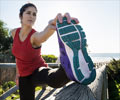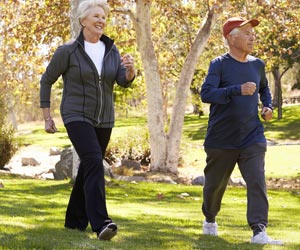According to a study released Wednesday, if running is your thing, you may want to throw away those pricey sports shoes and just do it barefoot.
According to a study released Wednesday, if running is your thing, you may want to throw away those pricey sports shoes and just do it barefoot.
Three-quarters of runners who wear shoes land squarely on their heels -- about 1,000 times for every mile run.But even well-cushioned sports shoes that help distribute weight across the foot cannot fully absorb the shock of these blows: 30 to 75 percent of regular runners each year suffer repetitive stress injuries.
By contrast, the vast majority of unshod runners don't hit the ground with their heels, landing instead on the sides or balls of their feet, the study found.
The practice is especially common in several east African countries where long-distance running is nearly a national past time.
In 1960, for example, a shoeless Abebe Bikila of Ethiopia won the 1960 Olympics marathon in record time.
By not "heel-striking," barefoot runners avoid painful and potentially damaging impacts that concentrate the equivalent of two or three times one's body weight on to a coin-sized surface.
Advertisement
"By landing on the middle or front of the foot, barefoot runners have almost no impact collision," he said in a press release.
Advertisement
But up to now, there has been little scientific evidence supporting the claim that barefoot is better.
Lieberman and colleagues helped fill this void by studying the gaits of three groups of runners in the United States and Kenya: barefoot, shod, and those who had converted to shoeless running.
"Most people today think that barefoot running is dangerous and hurts, but actually you can run barefoot on the world's hardest surfaces without the slightest discomfort and pain," the study found.
"All you need is a few calluses to avoid roughing up the skin of the foot."
But making the switch to barefoot running is not simply a matter of kicking off one shoes, the authors caution.
Running unshod or in so-called "minimal shoes" requires the use of different muscle groups. "If you've been a heel-striker all your life, you have to transition slowly to build strength in calf and foot muscles," Lieberman said.
The study, published in the British science journal Nature, also bolsters evidence suggesting the human foot evolved for rapid upright motion, said William Lungers, a professor at Stony Brook University Medical Center in New York.
"Bipedalism" -- walking on two feet -- "has been around for millions of years, and we have been unshod for more than 99 percent of that time," he wrote in a commentary, also in Nature.
A radical reshaping of the foot about two million years ago, including shorter toes and a fully-arched foot, probably occurred to enhance our ability to move quickly over sustained periods.
"Our endurance running abilities may have evolved to enable our ancestors to engage in 'persistence hunting'," the ability, in other words, to run down one's prey, he said.
Source-AFP
TRI










